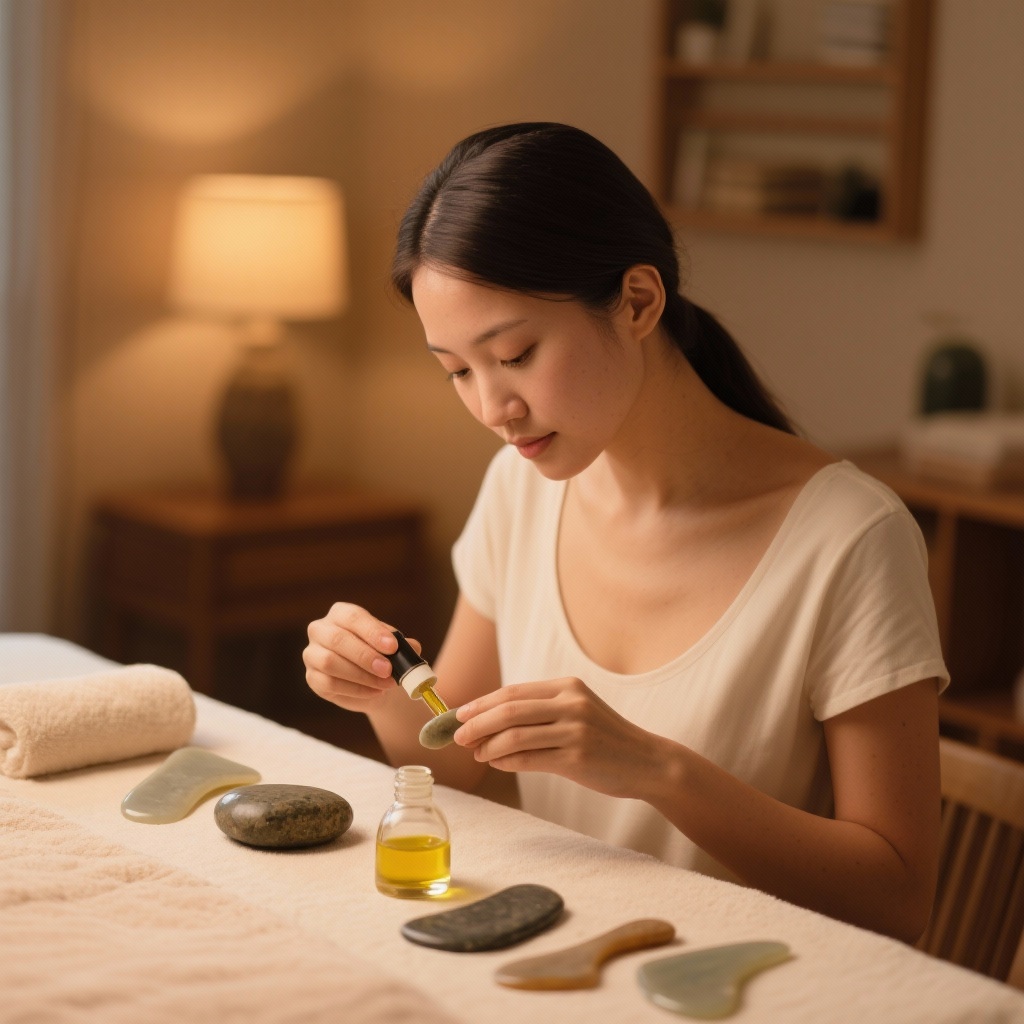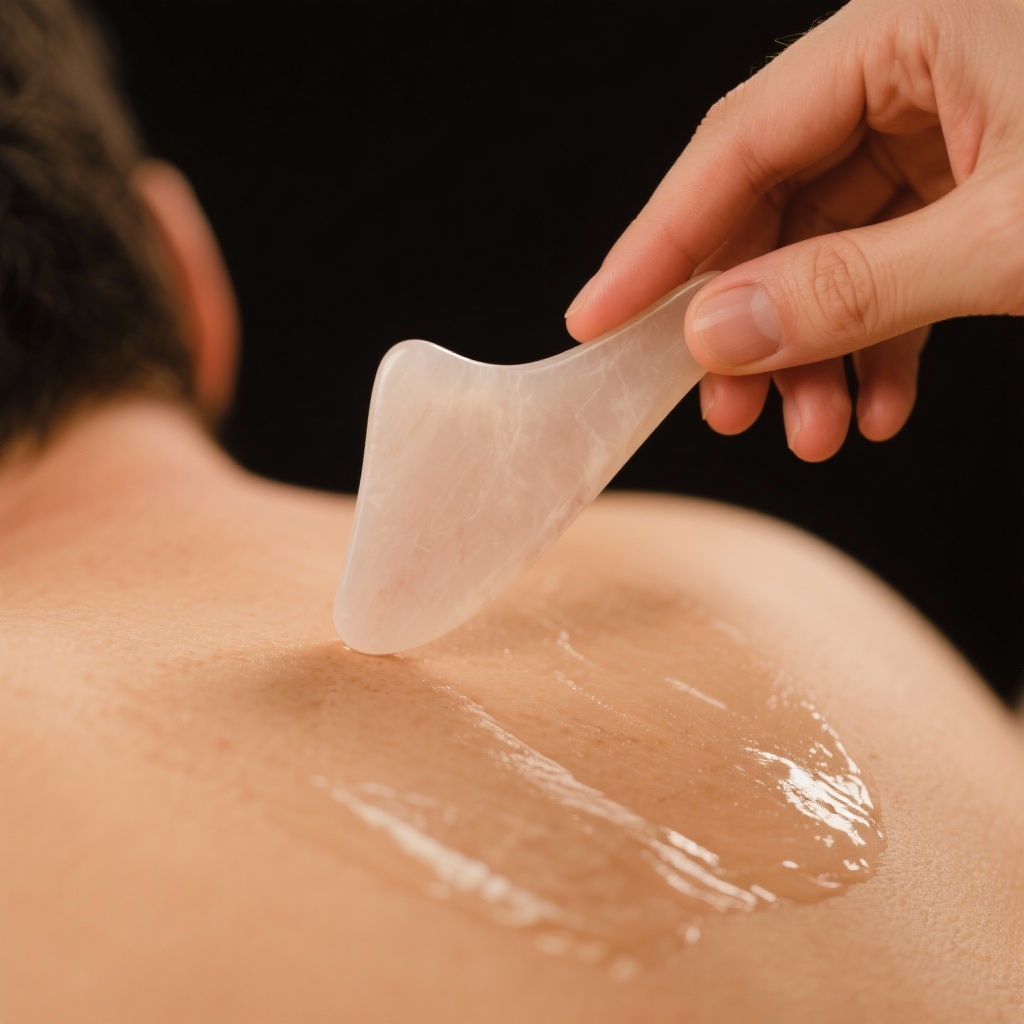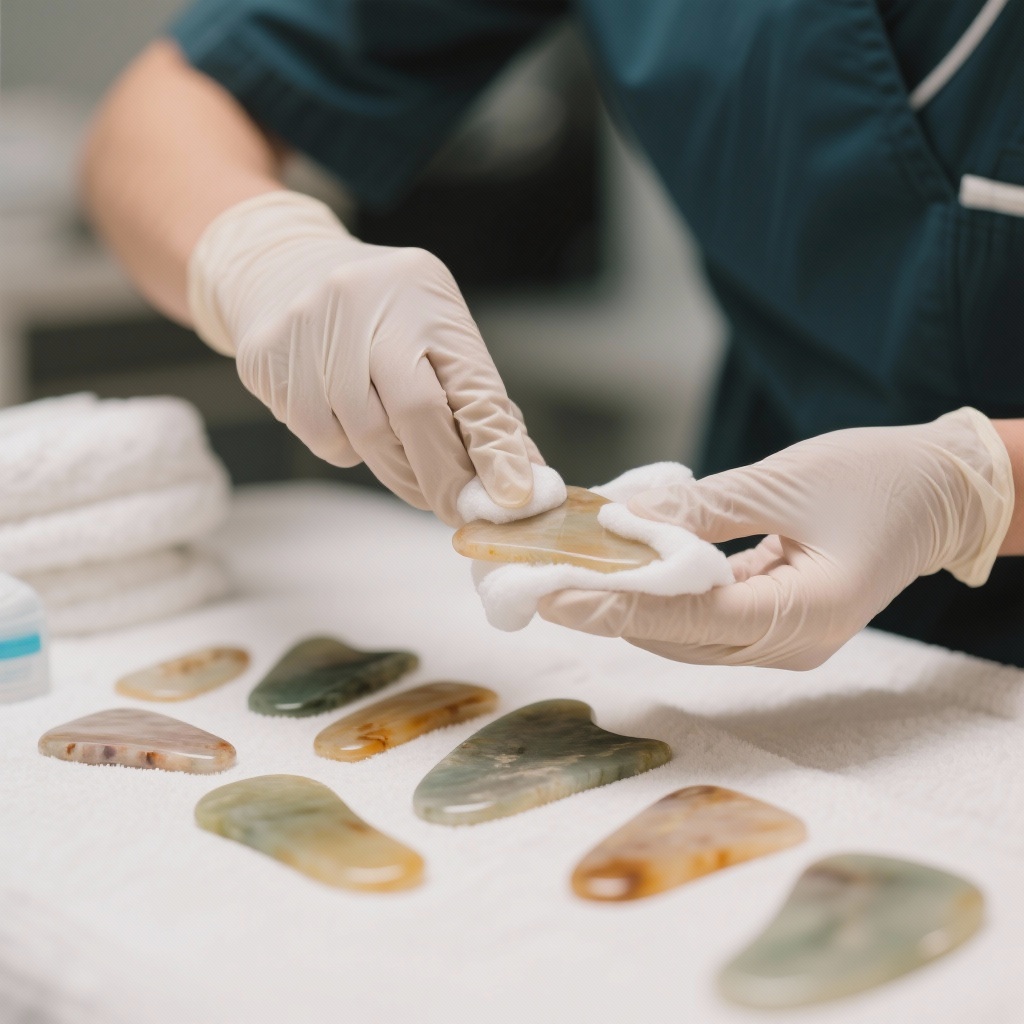Hey there, wellness seeker! Have you heard of Gua Sha? It’s an ancient Traditional Chinese Medicine (TCM) practice, often called “scraping,” that can offer fantastic benefits for your well-being. But like any powerful tool, understanding **Gua Sha safety** is absolutely essential. This comprehensive guide will ensure your experience is not only effective but also completely secure. You’ll learn the crucial dos and don’ts.

Prepping for Perfect Gua Sha: Get Set for Success!
Proper preparation ensures a smooth and beneficial Gua Sha session. This step is more crucial than you might think for optimal results. It sets the stage for a truly therapeutic experience.
Set the Scene: Optimal Comfort for Healing
Choose a suitable environment for your session. The room temperature should feel comfortably warm. Aim for around 77-82°F (25-28°C) to relax your muscles. Definitely avoid direct drafts or cold air blowing on you.
Select Your Tools: Smooth Surfaces Prevent Damage
Your Gua Sha tool matters significantly. Always pick one with a smooth, unblemished surface. Materials like buffalo horn, jade, or stainless steel are popular choices. Before each use, thoroughly clean and sanitize your tool.
Add Lubrication: Essential for Skin Protection
Pair your tool with a good lubricant. Gua Sha oil, Vaseline, or even a rich lotion works wonders. Applying lubricant prevents friction and protects your skin. Never, ever perform dry Gua Sha; it can cause damage.
Prepare Your Mind: Embrace the Process
Ensure the person receiving Gua Sha is fully relaxed. Explain each step of the process beforehand. This helps to alleviate any tension or nervousness. A calm mind enhances the therapeutic effect.
Mastering Your Movements: Smooth Strokes, Amazing Results!
Understanding the correct technique is paramount for effective and safe Gua Sha. The way you apply pressure directly impacts the outcome. This ensures you achieve benefits without causing discomfort.
Adjust Pressure: Listen to Your Body
Apply pressure gradually, always starting light. Increase it to a comfortable level, then gently ease off. The intensity should always be tolerable for the individual. Never push beyond what feels right.
Angle Your Tool: Glide, Don’t Drag
Hold the Gua Sha board at a 45-60 degree angle to the skin. Use a single, consistent direction for each stroke. Avoid scraping back and forth, as this can irritate the skin. Smooth, unidirectional strokes are key.

Control Speed: Gentle and Consistent Flow
Maintain a steady, slow scraping speed. Aim for approximately 20-30 strokes per minute. This rhythm allows the skin to respond effectively. Consistent movement promotes better circulation.
Observe “Sha”: No Need for Excessive Bruising
The appearance of “sha” (red spots) varies from person to person. Look for a reddish flush or small dark red marks. There’s no need to force a large amount of “sha.” The therapeutic goal is not excessive bruising. The “sha” signifies the release of stagnant energy, which Traditional Chinese Medicine describes as `qi` (pronounced “chee”), like a traffic jam in your body, obstructing smooth flow.
Absolutely Avoid: Knowing When Not to Gua Sha is Key!
Certain conditions make Gua Sha unsafe or entirely inappropriate. Identifying these contraindications protects both the practitioner and the individual. Your well-being is the top priority.
Serious Health Concerns: Prioritize Safety First
Individuals with severe heart conditions, or those experiencing a hypertensive crisis, should never receive Gua Sha. Pregnant women should also strictly avoid this practice. Similarly, those with severe anemia are not suitable candidates.
Skin Integrity Issues: Protect Compromised Areas
Never perform Gua Sha on broken skin, infections, or allergic rashes. Avoid areas affected by eczema or other skin sensitivities. Scraping compromised skin can worsen the condition or introduce bacteria.
Bleeding Disorders: Prevent Further Complications
Patients with conditions like leukemia or thrombocytopenia, which involve bleeding disorders, must not undergo Gua Sha. The scraping action could exacerbate internal bleeding. Always err on the side of caution.
Acute Illness & Weakness: Give Your Body a Break
During the feverish stage of acute infectious diseases, Gua Sha is contraindicated. Similarly, avoid it if you are extremely weak or severely hungry. Your body needs energy to heal, not to process scraping. Also, refrain from Gua Sha if you are drunk or within 30 minutes of taking a bath.
Gentle Touches: Special Considerations for Every Body!
Some individuals require a more nuanced and gentle approach to Gua Sha. Tailoring the technique ensures safety and comfort for sensitive or compromised populations. Adaptations ensure everyone can benefit appropriately.
Elderly and Children: Lighter Hand, Shorter Sessions
When performing Gua Sha on the elderly or young children, use exceptionally gentle techniques. Reduce the duration of the session significantly. Their skin is more delicate and sensitive to pressure.
Diabetes Patients: Extreme Care for Fragile Skin
Diabetic patients have skin that heals more slowly and is more prone to damage. Exercise extreme caution to avoid breaking the skin. Any cuts could lead to serious complications.
Anticoagulant Users: Medical Guidance is a Must
Patients taking anticoagulant medications are at a higher risk of bleeding. Gua Sha should only be performed under strict medical supervision for these individuals. Always consult a doctor first.
Menstrual Cycle: Specific Area Avoidance
During menstruation, women should avoid Gua Sha on the lower back and abdominal areas. Instead, consider lighter scraping on the upper limbs or facial regions. This respects the body’s natural rhythms.
Post-Gua Sha Bliss: Maximize Benefits, Minimize Worries!
Proper aftercare is crucial for enhancing the benefits of Gua Sha and preventing any adverse reactions. Following these simple steps will support your body’s healing process. It helps ensure a smooth recovery.
Stay Warm and Covered: Protect Against Cold
After your Gua Sha session, protect yourself from wind and cold. Dress warmly to keep your body temperature stable. Avoid taking a bath for at least two hours afterwards.

Hydrate and Detox: Flush Toxins Out
Drink plenty of warm water to boost your metabolism. This helps your body naturally eliminate toxins. Proper hydration is a key component of recovery. It supports overall well-being.
Eat Clean: Support Internal Harmony
Maintain a light and mild diet post-Gua Sha. Steer clear of spicy, irritating, or cold foods. Your body is in a state of adjustment, and gentle nourishment is best. You can find more information on supportive diets at Diet Therapy.
Rest and Recover: Allow Your Body to Mend
Get ample rest and avoid strenuous exercise. Also, try to keep your emotions calm and stable. Allowing your body to recover undisturbed is paramount. Rushing recovery can undo benefits. [PMID: 29596489]
Monitor “Sha” Fading: Give Skin Time
The “sha” marks typically disappear naturally within 3-7 days. During this time, do not re-scrape the same area. Allow your skin to fully recover before another session. Patience is truly a virtue here.
Unexpected Twists: How to Handle Rare Gua Sha Side Effects!
While generally safe, occasionally individuals may experience unexpected reactions during or after Gua Sha. Knowing how to respond quickly and effectively is vital. This ensures a swift and safe resolution.
Mild Discomfort: Simple Solutions for Dizziness
Slight dizziness or fatigue can be a normal reaction. Have the person lie flat and rest quietly. Offering warm sugary water usually brings quick relief. These minor symptoms often resolve easily.
“Fainting” (晕刮): Immediate Action for Severe Reactions
If severe dizziness, nausea, heart palpitations, or cold sweats occur (known as “晕刮,” or Gua Sha fainting), stop immediately. Have the person lie flat and provide warm water. If needed, firmly press the philtrum (人中穴) with your fingernail. This can help to revive consciousness.
Skin Damage: Prompt First Aid
Should any skin breakage occur, clean and disinfect the area promptly. If the damage is severe, or shows signs of infection, seek medical attention without delay. Prevention is always better, but knowing how to react is crucial.
Rhythm and Relief: Finding Your Optimal Gua Sha Schedule!
Establishing a suitable frequency and duration for Gua Sha sessions maximizes its therapeutic effects. This prevents over-treatment and ensures the body has adequate time to heal. Consistency combined with rest yields the best results.
Regular Sessions: Balancing Benefits and Recovery
Generally, 1-2 sessions per week are recommended. For acute conditions, you might increase frequency to every other day. This allows for more intensive intervention initially.
Chronic Conditions: Consistent, Longer-Term Care
Chronic issues often require a longer course of treatment. A typical cycle might involve 10 sessions over several weeks. Patience and persistence are key for enduring relief.
Rest Intervals: Crucial for Skin Regeneration
Allow at least 3-5 days between consecutive Gua Sha sessions. This provides sufficient time for the skin to fully recover. Never scrape the same area again if the previous “sha” marks have not completely faded.
Clean & Keen: Essential Care for Your Gua Sha Tools!
Maintaining impeccable hygiene and proper tool care is non-negotiable for safe Gua Sha. This practice prevents the spread of bacteria and ensures your tools remain effective. It’s a critical aspect of **Gua Sha safety** and effectiveness.
Tool Sterilization: Keep It Pristine
After each use, thoroughly wash your Gua Sha board. Wipe it down with alcohol or an appropriate disinfectant solution. Proper cleaning extends the life of your tools. Regular sterilization prevents infection.
Inspect Regularly: Spot Wear and Tear
Periodically check your tools for any cracks, chips, or rough edges. Worn or damaged tools can injure the skin. Replace them promptly to maintain a safe practice. This is a fundamental aspect of `Gua Sha Safety` (Source: The Yellow Emperor’s Classic of Internal Medicine).
Lubricant Quality: Choose Wisely
Always select reputable, high-quality lubricating products. Avoid using expired or compromised oils or lotions. Good quality lubricants enhance glide and reduce friction.
Operator Hygiene: Clean Hands, Safe Practice
The person performing Gua Sha must wash their hands thoroughly beforehand. Ideally, wear disposable gloves for enhanced hygiene. This ensures a clean and safe environment for everyone. These **Gua Sha safety** procedures are simple, easy, and *absolutely vital* for a beneficial experience. You are **safeguarding your skin**, **optimizing results**, and **preventing any unwanted side effects** when you follow these guidelines.

(Gua Sha is a traditional therapeutic modality with potential benefits for pain and well-being. Ensuring proper technique and hygiene is crucial for safe application.) [PMID: 29596489]
(Ancient texts emphasize the importance of clean tools and proper technique in therapeutic practices.) [Huangdi Neijing, Chapter 74]
(Understanding the vascular response during Gua Sha helps in avoiding adverse effects and optimizing therapeutic outcomes.) [PMID: 24707255]
Quick Self-Check & Relief: Instant Action!
* **If you feel lightheaded during Gua Sha:** Immediately stop, lie down flat, and drink a glass of warm, sweet water. You’ll likely feel better in minutes.
* **If your skin gets red or irritated after Gua Sha:** Apply a soothing, unscented moisturizer. Avoid sun exposure and let your skin rest for a few days.
Medical Disclaimer:This article is for educational use only and is not a substitute for professional medical advice.